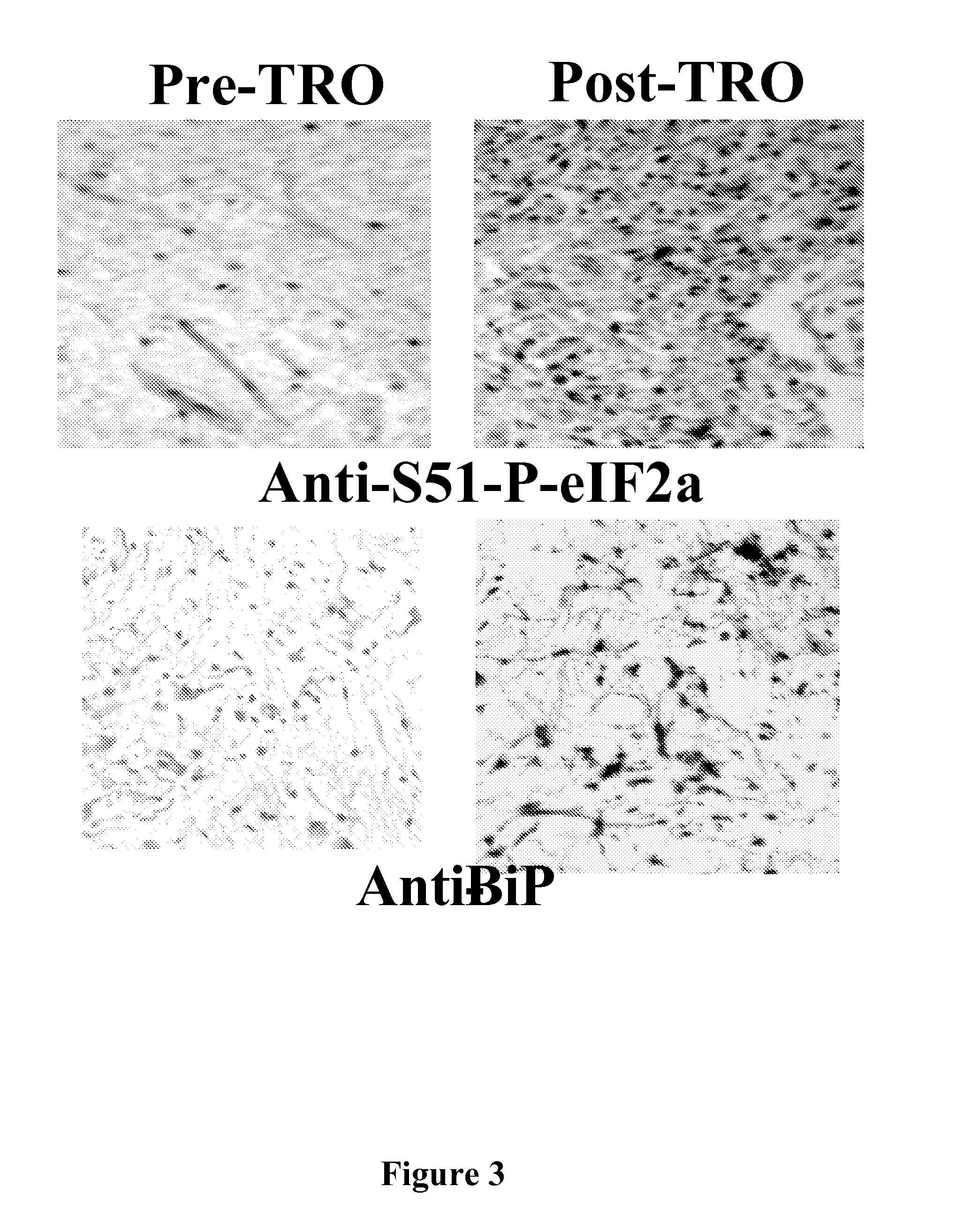DETECTION OF PHOSPHORYLATED eIF2-alpha AS A DIAGNOSTIC TEST FOR EFFICACY AND SENSITIVITY OF TRANSLATION INITIATION INHIBITORS IN THE TREATMENT OF CANCER AND OTHER PROLIFERATIVE DISEASES
a technology detection method, which is applied in the field of detection of phosphorylated eif2alpha as a diagnostic test for the efficacy and sensitivity of translation initiation inhibitor in the treatment of cancer and other proliferative diseases, can solve the problems of few if any anti-cancer drugs currently in use for the treatment of human cancers that meet the accreditation criteria, and achieve the initiation and maintenance of malignant phenotypes, suppressing malignant pheno
- Summary
- Abstract
- Description
- Claims
- Application Information
AI Technical Summary
Benefits of technology
Problems solved by technology
Method used
Image
Examples
example i
Target Accreditation of EPA in Human Cancer
[0100] Using phospho-S51-specifc anti-eIF2α antibodies, it was determined that EPA and TRO, two types of Ca++ mediated inhibitors of translation initiation, phosphorylated eIF2α tumors excised from cancer patients that were treated with one of these agents prior to surgery (FIG. 1A-1D and 2A-2E).
[0101] EPA
[0102] Although target accreditation is critical for the successful development of a target-specific anti-cancer drug, very few anti-cancer agents can be “accredited” in humans. Taking advantage of the fact that EPA is a food supplement, an Institutional Review Board (IRB) approved preliminary study was conducted in patients diagnosed with prostate cancer by prostate biopsy who later underwent radical prostatectomy at Brigham and Women's Hospital. In a double-blind, randomized, placebo-controlled study, the effect of each dietary intervention was assessed by comparing the level of eIF2α phosphorylation in the prostatectomy pathology spe...
example ii
Prevention of Recurrence or Spread of Metastases After Surgery for Treatment of Cancer
[0110] The present invention is also useful when a cancer patient is diagnosed by biopsy of having a particular type of cancer that is still amenable to surgical treatment. The patient will receive an inhibitor of translation initiation (e.g., EPA) for a period of time before surgery and then levels of eIF2α phosphorylation will be compared in the biopsy sample (i.e., a pre-surgical sample) to levels of eIF2α phosphorylation in the surgical samples.
[0111] An increase in eIF2α phosphorylation will support the continuous use of such a drug for prevention of recurrence and or spreading of metastases.
example iii
Prevention of Cancer Development After Biopsy Diagnosis of Cancer In Situ
[0112] The tumor suppressor BRCA1 is a major breast and ovarian cancer susceptibility gene. BRCA1 germ line mutations contribute to only 3% of all breast cancers in Caucasians, and somatic mutations are very rare in sporadic breast cancer (Khoo (1999) Oncogene 18:4643) and ovarian cancer (Merajver et al. (1995) Nat. Genet. 9:439).
[0113] Several lines of evidence strongly suggest that reduced expression of BRCA1 is involved in the etiology of 30-40% of sporadic breast and ovarian cancer (Taylor et al. (1998) Int. J. Cancer 79:334). Lower or undetectable levels of BRCA1 protein have been observed in sporadic breast cancer, and the majority of high-grade ductal carcinomas express very low levels of the BRCA1 protein as compared to normal mammary tissue and lobular cancers (Wilson et al. (1999) Nat. Genet. 21:236). A similar reduction of the BRCA1 protein has been observed in sporadic ovarian carcinomas. Id.
[011...
PUM
| Property | Measurement | Unit |
|---|---|---|
| Molar density | aaaaa | aaaaa |
| Molar density | aaaaa | aaaaa |
| Molar density | aaaaa | aaaaa |
Abstract
Description
Claims
Application Information
 Login to View More
Login to View More - R&D
- Intellectual Property
- Life Sciences
- Materials
- Tech Scout
- Unparalleled Data Quality
- Higher Quality Content
- 60% Fewer Hallucinations
Browse by: Latest US Patents, China's latest patents, Technical Efficacy Thesaurus, Application Domain, Technology Topic, Popular Technical Reports.
© 2025 PatSnap. All rights reserved.Legal|Privacy policy|Modern Slavery Act Transparency Statement|Sitemap|About US| Contact US: help@patsnap.com



